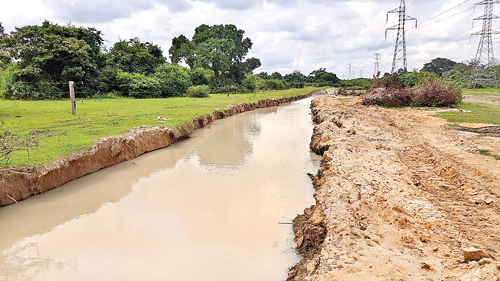News
Trenches project to mitigate HEC opens up bigger questions than answers

The trench project could raise many other issues as it was done without proper planning, say villagers. Pic by Nimal Jayaratne
A move by the State Ministry of Wildlife Protection to contract private companies to dig trenches as a means to prevent human-elephant conflict (HEC) has raised more questions than it has answered, even among long-suffering villagers in the worst-hit areas.
Both its legality and environmental impact are at issue. But former State Minister Wimalaweera Dissanayake last week insisted there’s no impediment to continuing the project as it’s under Department of Wildlife Conservation (DWC) supervision.
The Minister has been sworn in as the state minister for Disaster Management.
However, contractors have been digging trenches of 10 feet deep and 10 feet wide when the DWC recommendation is for 15 feet wide at the top and 10 feet wide at the bottom, with an inclination. The target area is more than 500km.
DWC sources divulged that the initiative is being carried out without research, expert opinion or environmental impact assessment (EIA) on the basis that it was urgent to prevent HEC. And they claimed these were not necessary under environmental laws.
Environmental groups opposing the project claimed it will have serious environmental impact. “The Ministry has given tenders to private construction companies to dig the trenches and they don’t care about the environment,” said Hemantha Withanage, Chairman of the Centre for Environmental Justice (CEJ). “They want to continue their business.”
The CEJ has filed a writ petition before the Supreme Court to halt the said project. There are seven respondents including Wimalaweera Dissanayake, who also holds the portfolio of Construction of Electrical Fences and Trenches, and Reforestation and Forest Resource Development.
Among the other respondents are Chandana Sooriyabandara, Director General (DG) of the DWC; Central Environmental Authority (CEA); Hemantha Jayasinghe, DG of CEA; Geological Survey and Mines Bureau; Sajjana De Silva, DG of the Bureau; and Dr. K. M. A. Bandara, Conservator General of Forests.
An EIA is imperative as this was a development activity taking place within a mile from the border of a national reserve, Jagath Gunawardena, environmental lawyer, said.
“According to provisions of Section 9 (A) Fauna and Flora Protection Ordinance the contractors have to get an EIA to carry out any development activity within close proximity to a national reserve,” he explained. “Although it comes under the supervision of the Wildlife Department, a private party is implementing the project. That party must make an application to get the EIA.”
There are environmental impacts from all these trenches, he warned: “They have to be have to be mitigated before the operations begin.”
The project beneficiary is the private company, although they are doing it for the State Minister and DWC. “It must obtain the relevant approvals,” Dr Gunawardena reiterated.
On February 1, a house in Polonnaruwa was destroyed after it was attacked by a wild elephant. Villagers told the Sunday Times that the animal had been roaming around for three days. They pointed out that they have been futilely demanding solutions for 39 years.
The trench project could raise many other issues as it was done without proper planning, said Karunaratne Banda, a farmer from Mahaweva, Welikanda, Polonnaruwa. “Wild elephants storm the village and destroy crops, property, and trample people to death. We cannot even have a good night’s sleep because of the issue.”
This is not a one-off occurrence in Polonnaruwa where multiple villages are located close to the forest. HEC has been on the rise, resulting in elephant and human deaths.
The private company said it was merely carrying out a contract. Any other problems must be discussed with the State Ministry or the DWC.
“We are doing this project free of charge,” claimed Upendra Rajapaksa, a contractor who is handling the work in Mahawewa. “The Government has not allocated any funds for it. To cover our cost, we have been asked to sell the soil and sand we excavate through digging.”
Villagers said around 70% of the area around Welikanda is sandy loam. When it rains, the dug trench collapses.
“We villagers got together and discussed the matter with the contractors,” Dimbulagala Rahulalankara Thera, Secretary of Buddhasasana Sangha Council, Dimbulagala said. “But they say they are doing it on behalf of the DWC and the State Ministry. And that subsequent issues should be discussed with the relevant ministers or officials.”
DWC statistics show that, during the first quarter of 2021, there were 114 human and 83 elephant deaths due to HEC.
The best way to say that you found the home of your dreams is by finding it on Hitad.lk. We have listings for apartments for sale or rent in Sri Lanka, no matter what locale you're looking for! Whether you live in Colombo, Galle, Kandy, Matara, Jaffna and more - we've got them all!

